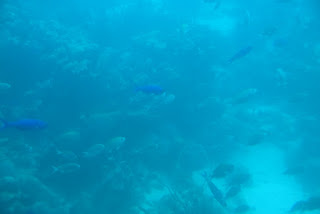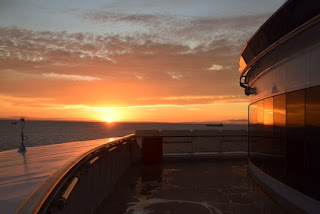We had one stop in the Caribbean en-route to NY. This was Aruba
which is a small island less than 40 miles off the Venezuelan coast. Although
not a bucket list item the idea of diving in a submarine had definite appeal
and with some 30 others we headed off in a small boat to find our sub.
It was a great experience
albeit a little cramped. The first stop at 30ft was a reef. With depth and the
subs windows the colour quickly reduced to shades of blue however there was clearly a lot of
life. The reduction in light meant the Blue Chromis stood out amongst its more numerous but differently coloured counterparts.
We then went lower to a small
wreck. This was deliberately sunk as an additional attraction to both humans and
fish.
As we dived further we were
accompanied by an Angel fish.
Eventually we bottomed out at
141 ft and literally touched base with the sea bed.
The 45 minute trip was over too soon. We had to wait on the surface for the shuttle boat to arrive and bounced around in the slight swell. Although the air conditioning and piped music had helped to ensure the trip was a calm experience it was good when the hatch opened and let in some fresh air. (Some of my neighbours....)
Meanwhile the captain awaited
his next visitors. As they operate up to 8 trips a day clearly cabin fever is
not an issue for him!
This was one port where a
good shot of QE was possible.
Two days later we were at
Fort Lauderdale and ticking off a further bucket list item – namely an air-boat.
These were a little larger than I had in my mind and carried some 30 passengers
and were powered by two huge Chevrolet 500 HP engines. Fortunately ear plugs were supplied.
We travelled up the canals
at such a speed it felt and sounded more like a drag race than an exploration of the everglades!
We did however get to see a
couple of Alligators.
Part two of this tour was a a
spell in the botanic gardens where the main draw card were the flamingos. They
looked very graceful
Until a couple of them became irritated with one another and
a noisy beak banging, squawking and attempted biting competition ensued. We had not
expected that.
Others in the gardens were
more relaxed including the iguanas and turtles.
While this shark turtle
(which is the largest species of turtle) could well have been dead based on the
amount of activity we witnessed.
Some
contrast was provided by these two otters who just could not keep still.
A peacock on full display and occasional feather shaking held a few of us humans spellbound. This was just as well
as the nearby pea hen showed absolutely no interest.
Although I had seen similar
displays I had not previously noticed the wonderful array of tail feathers and
in particular the large number of very downy ones half way down the back. The
closer one looks the larger the appreciation of the display. There is also a fair
bit of strength and balance involved especially when there is a bit of breeze around.
And that was then end of the
shore tours. As we awaited our departure a yacht travelled upstream which
necessitated lifting the dual carriageway bridge. Good timing.
And then we were off through
the entrance with two police boats working hard to keep all sorts of pleasure
craft a suitable distance from QE. It appears Sundays are pretty active
occasions here.
And two days later we pulled into NY in the early morning.
The views travelling up the Hudson were lovely as we sailed under the Narrows
bridge, past the Statue of Liberty and Ellis island to our mooring at Pier 93.
The ships movements and darkness prevented suitable shots until a bit of
daylight crept in. We moored two piers up from the aircraft carrier Intrepid
(see Sept 2014 blog for more on this visit). What was a standout was how big QE
was compared to Intrepid – we overhung the pier and looked down on the roof of
the space display.

































































